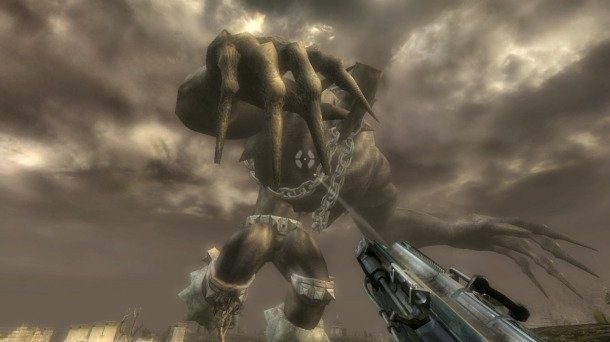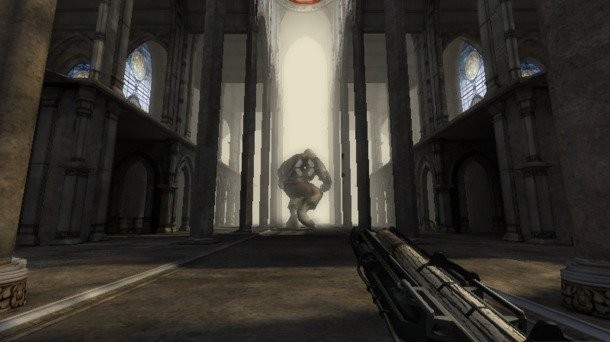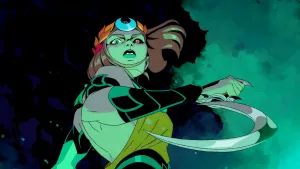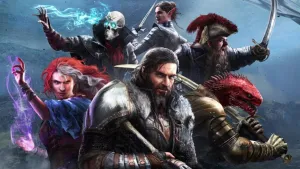Before Bulletstorm, There Was Painkiller
"Pfffff. Dude. That was 2002! Hang on, what was the idea? Hmm. I was drunk..."
People Can Fly creative director Adrian Chmielarz is exactly what you might think the man behind Painkiller and Bulletstorm is like. The eccentric Polish studio head is one of the least rehearsed developers to ever sit in front of a camera, as you'll soon see for yourself in our upcoming video interview with him about this month's cover story. Chmielarz's enthusiasm for Painkiller is no less infectious than his love for Bulletstorm; this is a guy who truly believes in the work he does: making killing ridiculous enemies as awesome as possible.
The video game development scene eight years ago was much different than it is today. The PlayStation 2 reigned uncontested on console, and you could make a modern-looking PC first-person shooter on a shoestring budget. If your passion was to make an off-the-wall FPS with 200-foot tall bosses and guns that shoot both shurikens and lightning, you could make that a reality.
"[Making Painkiller] was a half-commercial, half-born-out-of-love decision. We looked at the market, and we all loved shooters, so we knew we wanted to make a shooter. But there were a lot of -- believe it or not, in 2002 there were a lot of World War II games -- and a lot of military kind of stuff. We thought to ourselves, 'Remember that game Heretic? It was slightly different, it had these horror undertones in it. Why is that not happening any more? That was pretty cool.' So actually, Painkiller started as a horror shooter," Chmielarz remembers. "But yeah, we are crazy. We could not hold on to the serious tone. So we started adding clown mutants and all that kind of crazy stuff [laughing]. We still tried to keep that horror tone in the game, but we failed miserably and you have really weird stuff going on in Painkiller."
The game starts out recognizably enough. The gloomy cemetery and spooky ambient music speak of the dread to come. Then an unseen electric guitar starts shredding and huge stone gates slam into place and lock you into a tiny arena while zombies pop out of the ground and sprint toward you. Armed only with the PainKiller -- which is equally competent at kibbling enemies in melee range with its spinning blades or pasting them from range by launching its detachable head -- you go to work. Messy, violent work.
Chmielarz owns up to the game's ludicrous premise. "We had no story in Painkiller. I mean, yeah, there was a story, but...pfff," he chuckles. The plotline was realized in no more detail than absolutely necessary to give players a reason to shoot a bunch of enemies in a series of combat arenas, punctuated by encounters with Satan's four enormous generals. There was no in-game reason for the doors to lock (or arbitrary forcefields to cover the exits) and dozens of enemies to spawn once you crossed each invisible threshold -- the point was to wreck a bunch of dudes, and that's exactly what you did.
"I think that the best feature of Painkiller is something that we also have in Bulletstorm, which is the sandbox nature of the combat," says Chmielarz. "After Painkiller was released, we saw people doing crazy stuff that we had never thought of ourselves."
Painkiller's inventive weaponry is the biggest part of this. The shotgun is amusing enough by default, but cranked-up Havok physics ensure that every last bit of cannon fodder dies in entertaining fashion, and its freeze shot alt-fire also leads to excitingly chunky deaths. The stake launcher pins enemies to the wall to flop helplessly, and offers a secondary grenade launcher for dealing with groups. The shuriken gun is an excellent long-range weapon, and includes a close-range lightning blast for frying nearby fools.
The progression of enemies, which starts with simple sword-wielding zombies and proceeds through fireball-tossing, scythe-brandishing priests to teleporting, blowgun-firing ninjas and beyond, acts as a solid difficulty curve that also encourages players to experiment with the unusual weapons. Likewise, a good variety of environments requires different tactics -- circle-strafing works great until you're stuck on a series of catwalks and can't effectively dodge incoming projectiles. Painkiller's combat is built on simple pieces, but the care with which they are mixed and matched throughout the long campaign results in excellent gameplay.
Comparisons to Serious Sam are unavoidable, but the skill with which People Can Fly constructed Painkiller puts it a notch above in every department. Not to bag on Serious Sam -- which I enjoy for what it is -- but having re-played both recently, Painkiller holds up much better.
Painkiller also enjoyed a run as the official 2005 World Tour game of the Cyberathlete Professional League, which used a 1-on-1 deathmatch formula for its events. Beating out Unreal Tournament 2004 (surprising) and Doom 3 (not so much) for the honors, Painkiller was supplanted in 2006 by Quake 3. In an unusual move for a pro competition, Painkiller's popular European-developed PK++ mod was used rather than the base game.
The first expansion, Battle out of Hell, is worth playing as a solid extension of the base game (and comes bundled with the Black edition of the game, which is available for $10 or less from various retailers). Publishers Dreamcatcher, and later JoWood, pumped out two more non-People Can Fly-developed expansions, Overdose and Resurrection, but neither are anything you should bother with. Whatever strange alchemy was happening at People Can Fly, it was not recreated with any success by subsequent developers.

As enthusiastic as I still am about the game, it has plenty of less-than-stellar elements. The collection metagame, which has you fulfilling special goals to unlock ability-granting Black Tarot cards which you can then place using gold you've found, is largely terrible. A few of the goals push you to play levels in unorthodox, creative ways, but most of them add tedium and slow down the generally solid pacing of a map. Painkiller is a game meant to be played on the edge of your seat, progressing from fight to fight without so much as a pause to reload. Scouring the levels for hidden areas and every last piece of gold is not fun at all. It's not often that a metagame doesn't just fail to enhance but actively detracts from the core gameplay, but it manages to here.
Painkiller ultimately is what it is: a series of amusing combat sandboxes barely held together by a laughable excuse for a plot. Fortunately, every slaughtered enemy is a joy and each new level is a unique spectacle. Relative to the resources put into it, Painkiller is a masterpiece. "What many people do not realize about Painkiller is that it looks like a real game," Chmielarz laughs. "But it was done in two years by fifteen guys, for a price that I don't even want to mention, but nobody will work for that kind of money any more in this industry. An iPhone game, maybe? So considering all that, I don't think there's anything I would have done differently."

Get the Game Informer Print Edition!
Explore your favorite games in premium print format, delivered to your door.
- 10 issues per year
- Only $4.80 per issue
- Full digital magazine archive access
- Since 1991












